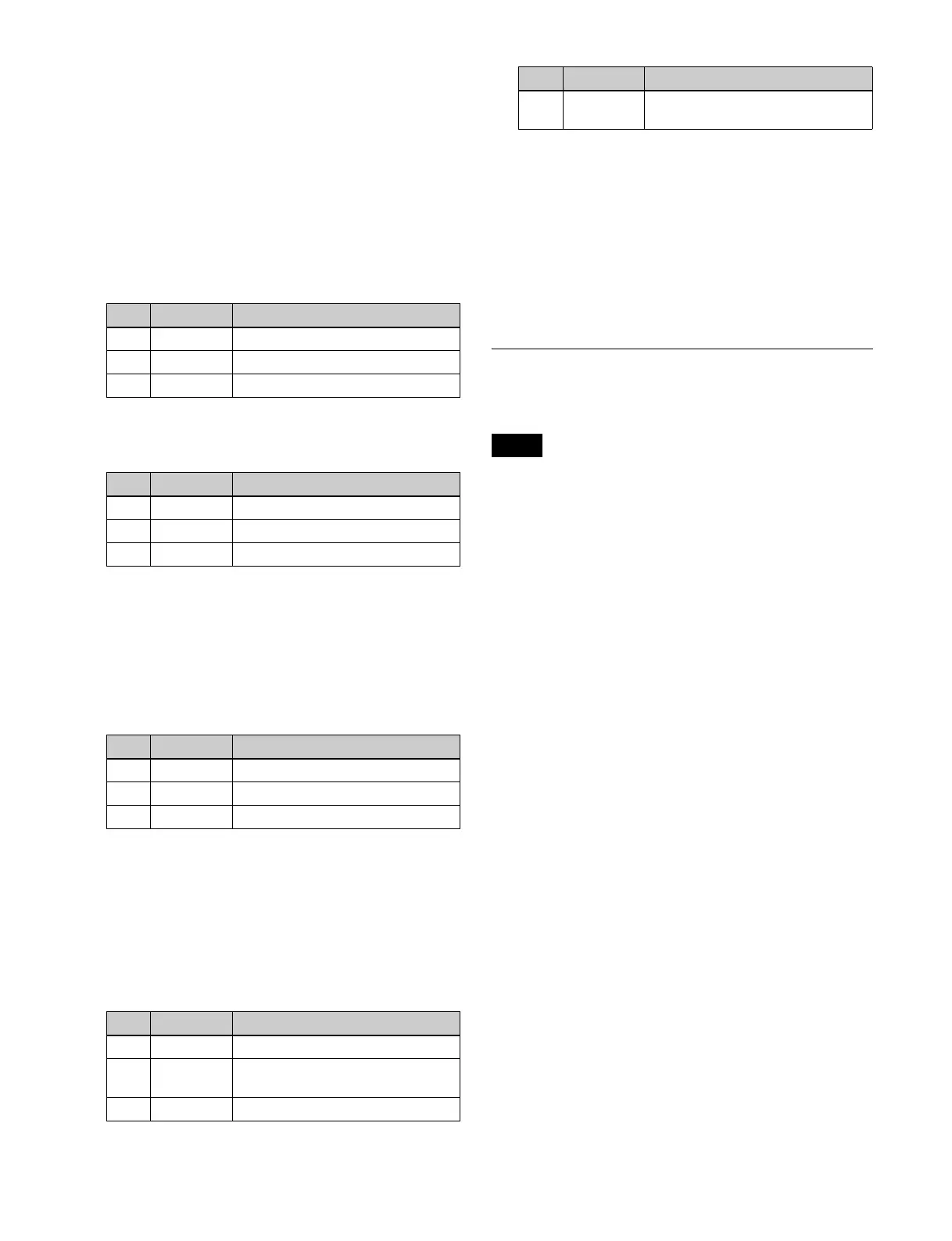244
page 214), Trail (see page 240), and Wind effects. If
[Mix Color] or [Ext Video] is selected for one of these
effects, the [Mix Color] or [Ext Video] for the other
effects is disabled, and [Flat Color] is selected in its
place.
• When executing a 4-channel combination, [Mix Color]
and [Ext Video] cannot be selected.
Freeze Video: Freeze the input image to use as the
afterimage.
Flat Color: Uses a single color matte as the afterimage.
You can set the following parameters.
Hue Rotate: Use a color matte whose hue varies slightly
with each frame for the trail of the afterimages. You
can set the following parameters.
Mix Color: Insert a mix color signal (see page 219) in the
afterimage portion.
Ext Video: Insert an external video signal input from Ext
In in the afterimage portion.
Rainbow: Use a freeze image with the hue changing every
frame in the afterimage portion. The difference from
[Hue Rotate] is that many colors appear
simultaneously. You can set the following parameters.
Modulating the afterimage portion
(Modulation)
1
In the DME >Light/Trail >Wind menu (4155), press
[Modulation], turning it on.
2
Set the following parameters.
Other settings
You can also set <Priority> group, <Wind Freeze Timing>
group, <Combine Process> group, [Wind Eraser],
[Defocus], and [Dust] settings.
The operation is the same as <Priority> group, <Trail
Freeze Timing> group, <Combine Process> group, [Trail
Eraser], [Defocus], and [Dust] in the Trail menu (4152).
For details, see “Trail Settings” (page 240).
Spotlighting Settings
You can set up to three light sources (lights 1 to 3).
When the global effect combiner function is enabled, the
settings of the lowest-numbered channel selected for the
combiner are enabled.
Adjustments to the image surface
The following adjustments can be made to the image
surface struck by the light.
• Adjusting the brightness of the whole image
• Selecting the image surface effect
• Test sphere function
• Adjusting the roughness of the image surface
• Coordinate axis on surface of image
Selecting the image surface effect
Flat: The image surface is unchanged, causing the selected
light source to appear as the effect.
Non Linear: Spotlighting effect is applied to an area to
which a DME nonlinear effect is applied.
Test sphere function
A test sphere is a translucent sphere virtually embedded in
the center of the input picture to provide an intuitive way
for you to check the position and direction of the spotlight.
When you change the position or direction of a light
source, the side of the sphere closest to the light source
grows brighter.
For details, see “Relation between test spheres and
parallel light rays” (page 246).
Coordinate axis on surface of image
This sets whether the coordinates of a test sphere on a
surface move in conjunction with a DME image.
Move: The test sphere moves together with the DME
image.
No. Parameter Adjustment
1 Luminance Luminance
2 Saturation Saturation
3Hue Hue
No. Parameter Adjustment
1 Luminance Luminance
2 Saturation Saturation
3 Hue Speed Speed at which the hue changes
No. Parameter Adjustment
1 Luminance Luminance
2 Saturation Saturation
3 Hue Speed Speed at which the hue changes
No. Parameter Adjustment
1 Amp H Horizontal amplitude of the wave
2 Freq H Frequency of wave in horizontal
direction
3 Amp V Vertical amplitude of the wave
4 Freq V Frequency of wave in vertical
direction
Note
No. Parameter Adjustment
